The daffodils are creeping up. I've seen lots of robins and bluebirds lately. The long, icy winter is over and the "slow rescue season" has given way to my favorite season ... mud season. I love watching everything come back to life.There really isn't a slow season anymore at Red Maple Farm. We are doing rescues every day, all year long, usually around 400 animals a year. We never have a day off. We even had a duck come in on Christmas morning. With our current economic recession, I've been getting lots of calls from good people that are in over their heads financially. I think that it is amazing that these people are struggling to survive yet they care so much about their animals that they know that they can no longer take care of them and want to get them in a better spot--versus a livestock auction ... or watch them starve. Spring is our busiest season of the year and I look forward to the orphaned wildlife that will be arriving shortly. One of my students told me yesterday, at school, that the bears are out of the dens and on the move again. I am hoping this year to have the opportunity to rehab bear cubs. We have started building the second phase of NY Wildlife Rescue Center. Last year, we put all of our time and donations into building a beautiful mammal area. This year, we have already started to build our raptor center for hawk, owl and falcon rehab. We are building the indoor facilities for eight species right now, as donations keep coming in. By fall, I hope to have the 150 foot outdoor flight completed. We rescue a lot of birds of prey. All of the rehabbers that network through this facility do a great job with the animals that we get in. I've always thought that birds with wing injuries should have a place to exercise before being released back into the wild. When completed, this facility will be the largest of its kind in NYS. I believe that many NY State Wildlife rehabbers will bring their birds here to finish recovery and then pick them up to take them back to where they were found for release.
I should probably catch everyone up with 2009. One of my many goals this year is to blog regularly to let everyone know what animals have come in--there are so many stories to tell for each animal. New Years Eve started with a baby lamb born to the Alaskan Dahl Sheep that I picked up last fall from another rescue facility. New Years Day, we received a small whitetail deer that was hit at Crossgates Mall. One of my students saw the deer get hit, thought it was dead and was going to throw it on the back of his truck, take it home and eat it.... The poor fawn must have thought that it was the lead character of a bad horror movie when it came out of shock on the floor in the back seat of his truck. I really wouldn't suggest putting a deer in your vehicle that has been hit by a car. I actually had two women bring me a fox in their trunk last fall (which I really wouldn't suggest either) but that is a story for my book. The beginning of January was busy. I got a call from a guy that had a skunk in his woodshed that he wanted evicted. I set a live trap and have caught a lot of interesting things but still haven't caught the skunk--but I will.
This time of year is when we get a lot of animals hit by cars. They feed and travel by roads since there is less snow and more food. January 5th, we received a Screech Owl that was hit by a car. The student from my school did everything right but, unfortunately, by the time they got it to me it had died. A couple of days later, some great folks brought me a pileated woodpecker (one of the big ones) that had been hit by a car; it wasn't looking too good and died shortly after arrival. It is depressing to see such cool animals check out. Doing what we do, you really need to focus on the "saves" not on the "would have, could have and should haves".
On January 8th, a DEC guy brought me a little Pine Siskin that was sitting by his bird feeder acting strange. I had a Goldfinch come in (no they don't always migrate) that had really bad conjunctivitis in its eyes. Over the last year, we have seen a lot of song birds come in with this eye ailment. It is fixable but it is fatal in the wild since they get blinded by the crust. The same day that the Goldfinch came we had a Coopers Hawk arrive. The folks rushed it to me and it was dead from the collision (by the sounds of things) with their deck sliding glass door. I don't know how close their birdfeeder is to their house but birdfeeders should be a safe distance away, yet close enough to enjoy the birds. This hawk was probably hunting the birds at their feeder.
I love raptors. Talons and sharp beaks: birds that hunt prey intrigue me. On January 28th, I was enjoying a snow day from school and the blizzard that came with it. Right about the second cup of coffee, after am chores got done, the phone rang. It was a call from about 30 minutes away on an owl that was sitting in the middle of a busy road. I returned the call and reluctantly came off the mountain to creep towards the half way mark (where we had agreed to meet) for the pick up. The Barred Owl didn't look too good. It was very thin, lethargic, and I wasn't optimistic. I got it back to the shop and got some fluids into it with a lactated ringer and it started to come back to life. Kelly Martin took him to fatten him up with her Barred Owls and I had the privilege of releasing the owl back into the wild where it was found with the folks that had saved it. The slideshow is on our website: check it out. That is what it is all about; the reason why we rehab wildlife.
We have had a couple of other screech owls come in, and some are still in rehab. One was actually taken out of the grill of a big rig by a trucker. In February, a DEC officer called me to give me the names and the number of some great folks that had saved a hawk. I met them part way, in a convenience store parking lot, to pick up the bird. Once I got up to fellow rehabber Kelly Martin's house we tag-teamed to see what was wrong with the bird. The Rough Legged Hawk isn't something that we pick up often. Part of the wing had been broken and we soon found a huge chest wound as well. The bird was stabilized and went to the vet the next day for surgery and still is in rehab. My gut feeling told me that it was a gunshot wound. It couldn't be proven, but it is a federal crime to shoot a bird of prey. I can't think of any reason why anyone would want to do such a thing. This bird is alive but it will most likely be unreleasable and will need to be put on our educational permits.
The last two mammals that came in were Brown Bats. I think that they came out of their winter stupor a little too early and got cold. They will be released back to where they were found when the weather gets warmer. Do you know that 20% of the earths mammals are bats? I think that they are awesome and they save billions of dollars in agricultural damage by eating all of the bugs over our crops. Two things alarm me with bats right now. The first is the white nose disease that appears to be destroying certain colonies of bats. The second is the huge numbers of bats that are being killed in windmill fields. These are things that make you go "hmmmmmm".
On that note, I've caught everyone up to speed and I can go back to normal blogs from now on. Right now, I need to go to the barn and say goodnight....
I'll be back soon, I promise,
WES
PS: Thanks to everyone that has been sending donations for the llamas that I just picked up. We also still need to raise a lot of money to keep going on the raptor center construction. Please tell everyone that you know about us ... all contributions are tax deductible to the extent allowed by law. See our sponsorship levels on our website and donate if you can, when you can. Thanks!
Please also see our other blog at
http://nywildliferescue.blogspot.com/
It is more active than this one. Always check there for updates, too.
Northeast Llama Rescue was started by Wes and Darcy Laraway of Middleburgh, NY.
Several years ago they rescued their first llama out of a tiny horse pen. Since that day, Northeast Llama Rescue has helped dozens of Camelids from several different states. The primary mission of Northeast Llama Rescue is to educate owners on how to properly care for their animals.
We also offer assistance with a traveling chute to shear, worm, and trim toenails on hard to handle animals. A 'TRUE REPUTABLE BREEDER" should help out the llama down the road that is not being cared for by owners that understand the needs of llamas.
If you know of a llama owner who is no longer able to care for their animals, there is help available. Members of Northeast Llama Rescue will adopt any unwanted animals. Rescue animals will be relocated to farms of members for training and necessary vet work.
If a llama is able to be rehabilitated, he will be available after a careful screening process. All rescues are placed in homes with a contract that says they shall be provided for and can not be sold. In the event a rescue animal becomes unwanted, the llama MUST be returned to Northeast Llama Rescue.
If you share our philosophy and love for the animals, you are more than welcome to join us! There are lots of llamas that need a person to love.
We also rescue farm animals, and are licensed wildlife rehabilitators.
This site is copyrighted by Wes Laraway.
Thursday, March 19, 2009
Subscribe to:
Post Comments (Atom)
Northeast Llama Rescue by Wes Laraway
The Northeast Llama Rescue was started by Wes and Darcy Laraway several years ago after they rescued their first llama out of a tiny horse pen. Since that day, the Northeast Llama Rescue has helped dozens of animals in 5 states. The primary mission of Northeast Llama Rescue is to educate owners on how to care for their animals properly. We also offer assistance with a traveling chute to shear, worm and trim toenails on hard to handle animals. If owners get "tired" of the daily maintenance of their herds, members of the Northeast Llama Rescue will adopt or buy, if possible, any unwanted animals. Rescue animals go to the farms or members of the organization.
The Northeast Llama Rescue does not wish to compete with other rescue organizations, although any llama or alpaca is welcome. We need to cooperate to help ALL camelids, not just registered or "nice-looking" ones. Everyone has the right to breed and sell llamas, but a true reputable breeder will "help out" the llama down the road that is not being cared for, regardless of its age, sex or conformation.
Our last rescue came from Central New York. A farm had purchased 9 animals from a Midwest auction. Four of the animals had died from natural causes....starvation? The owner had health problems and no longer wanted the animals. After several other concerned people failed to negotiate their sale, I eventually called and within five minutes we had agreed on a price and the deal was done. The next night, Wes Laraway, Kim Scheurerman and P.J. Wagner went to pick up the animals. The owner informed us that the llamas were wild and could not be handled. Within five minutes all were calmly caught, on lead ropes and in the trailer, with us using a wand and some TEAM Training techniques. The owner thought I was the "llama whisperer" because I got those llamas to do things in five minutes that she couldn't do in a year. She unfortunately knew nothing about handling llamas.
Three hours later, we were back into quarantine at Red Maple Farm starting "damage control". The animals were immediately wormed, fed fresh hay and grain, and watered. All were body scored under three by sight and by feeling through their wool. This hands-on inspection revealed barbed wire that needed to be cut out of the fiber. We decided NOT to shear because it was too late in the year and they were too thin.
Another concern was an ingrown halter. One of the best ways to remove ingrown halters is to undo the buckle(s) and cut the nose band with sharp toenail clippers on each side of the nose. Then gradually, over time, the remaining pieces will fall out. With application of an antibiotic cream, any wounds from the ingrown halter will heal quickly. In this particular case, the halter came out of the nose and was added to the "wall of shame" in our barn (along with the barbed wire and ear tags still on them from the auction they were purchased from). The blood stream stopped within fifteen minutes and now, after a month, we can tell that scarring will be minimal. Please tell everyone you know that owns camelids, NEVER leave a halter on a llama! Even in a week, with wet conditions, a halter can embed itself in a llama's nose.
My biggest concern was the 10 month old female that was exposed to her father. If bred, we decided to abort the unborn cria for the safety and well-being of the young female. None of these five animals were over the age of three years. All of them, over the following months, would need intense care and proper nutrition. The animals were all updated on health requirements and gelded. All of these animals would need training before they could go up for adoption.
New problems continuously arose. Two weeks after they arrived, one of the females surprised us with a weak, constipated fourteen pound male cria. Within hours I knew it wasn't "normal" so mom and baby were moved to a quarantine pen in the barn. The decision was made to supplement the cria with goat colostrum and give him an enema. Although the cria was walking, he continued to strain to relieve himself. Around the clock surveillance did not reveal any nursing or defecation. At two days old, I found very small maggots between the cria's toes and by his umbilical cord. After consulting my vet again, the cria got a bath and dried out in the heated office before going back to mom in the barn. My vet explained that crias born on rainy days must be completely dry or flies will lay eggs in moist areas of umbilical fluid. I've never heard of this problem before but I know now to check my newborn crias for maggots every day. After five days of constant care, we lost "Trooper"....I guess it was not meant to be, but we tried.
The rest of the animals are doing well today. Concerned individuals found them, bought them and will protect them. Today is actually a special day, because the vet did fecals on them and all five of them are parasite free and can join our llama herd. After training and further rehabilitation, by Spring 2001 this group of animals will be available for adoption to carefully approved homes. All animals sold or placed by Northeast Llama Rescue will be adopted with a legal contract. The contract states that if the llama ever becomes unwanted or is not cared for properly, the animal will return to Red Maple Farm for a full refund. I used to think I could save every unwanted llama in the world...I know that I can't . It is too great an undertaking for one farm to rescue all the unwanted camelids out there. For this reason, several other farms have joined in the effort with Red Maple Farm to pool resources and save neglected and unwanted camelids.
Any farm that shares our philosophy that every llama deserves a life with proper care is welcome to join us. We are people who genuinely love all llamas and want to make a difference one llama at a time. Eventually we will print an educational brochure to hand out at events with member farms listed. Don't just tell people that you love your llamas; show people by making a difference and actually save one. Always quarantine new animals for at least one month while getting wormings, vaccines and nutritional needs in order. Always do a fecal exam and consult your vet about when new animals should go out with the herd. Geld all males and most of all BE PATIENT. Llamas are very forgiving animals and will learn to love and trust again with gentle care and training.
The Northeast Llama Rescue does not wish to compete with other rescue organizations, although any llama or alpaca is welcome. We need to cooperate to help ALL camelids, not just registered or "nice-looking" ones. Everyone has the right to breed and sell llamas, but a true reputable breeder will "help out" the llama down the road that is not being cared for, regardless of its age, sex or conformation.
Our last rescue came from Central New York. A farm had purchased 9 animals from a Midwest auction. Four of the animals had died from natural causes....starvation? The owner had health problems and no longer wanted the animals. After several other concerned people failed to negotiate their sale, I eventually called and within five minutes we had agreed on a price and the deal was done. The next night, Wes Laraway, Kim Scheurerman and P.J. Wagner went to pick up the animals. The owner informed us that the llamas were wild and could not be handled. Within five minutes all were calmly caught, on lead ropes and in the trailer, with us using a wand and some TEAM Training techniques. The owner thought I was the "llama whisperer" because I got those llamas to do things in five minutes that she couldn't do in a year. She unfortunately knew nothing about handling llamas.
Three hours later, we were back into quarantine at Red Maple Farm starting "damage control". The animals were immediately wormed, fed fresh hay and grain, and watered. All were body scored under three by sight and by feeling through their wool. This hands-on inspection revealed barbed wire that needed to be cut out of the fiber. We decided NOT to shear because it was too late in the year and they were too thin.
Another concern was an ingrown halter. One of the best ways to remove ingrown halters is to undo the buckle(s) and cut the nose band with sharp toenail clippers on each side of the nose. Then gradually, over time, the remaining pieces will fall out. With application of an antibiotic cream, any wounds from the ingrown halter will heal quickly. In this particular case, the halter came out of the nose and was added to the "wall of shame" in our barn (along with the barbed wire and ear tags still on them from the auction they were purchased from). The blood stream stopped within fifteen minutes and now, after a month, we can tell that scarring will be minimal. Please tell everyone you know that owns camelids, NEVER leave a halter on a llama! Even in a week, with wet conditions, a halter can embed itself in a llama's nose.
My biggest concern was the 10 month old female that was exposed to her father. If bred, we decided to abort the unborn cria for the safety and well-being of the young female. None of these five animals were over the age of three years. All of them, over the following months, would need intense care and proper nutrition. The animals were all updated on health requirements and gelded. All of these animals would need training before they could go up for adoption.
New problems continuously arose. Two weeks after they arrived, one of the females surprised us with a weak, constipated fourteen pound male cria. Within hours I knew it wasn't "normal" so mom and baby were moved to a quarantine pen in the barn. The decision was made to supplement the cria with goat colostrum and give him an enema. Although the cria was walking, he continued to strain to relieve himself. Around the clock surveillance did not reveal any nursing or defecation. At two days old, I found very small maggots between the cria's toes and by his umbilical cord. After consulting my vet again, the cria got a bath and dried out in the heated office before going back to mom in the barn. My vet explained that crias born on rainy days must be completely dry or flies will lay eggs in moist areas of umbilical fluid. I've never heard of this problem before but I know now to check my newborn crias for maggots every day. After five days of constant care, we lost "Trooper"....I guess it was not meant to be, but we tried.
The rest of the animals are doing well today. Concerned individuals found them, bought them and will protect them. Today is actually a special day, because the vet did fecals on them and all five of them are parasite free and can join our llama herd. After training and further rehabilitation, by Spring 2001 this group of animals will be available for adoption to carefully approved homes. All animals sold or placed by Northeast Llama Rescue will be adopted with a legal contract. The contract states that if the llama ever becomes unwanted or is not cared for properly, the animal will return to Red Maple Farm for a full refund. I used to think I could save every unwanted llama in the world...I know that I can't . It is too great an undertaking for one farm to rescue all the unwanted camelids out there. For this reason, several other farms have joined in the effort with Red Maple Farm to pool resources and save neglected and unwanted camelids.
Any farm that shares our philosophy that every llama deserves a life with proper care is welcome to join us. We are people who genuinely love all llamas and want to make a difference one llama at a time. Eventually we will print an educational brochure to hand out at events with member farms listed. Don't just tell people that you love your llamas; show people by making a difference and actually save one. Always quarantine new animals for at least one month while getting wormings, vaccines and nutritional needs in order. Always do a fecal exam and consult your vet about when new animals should go out with the herd. Geld all males and most of all BE PATIENT. Llamas are very forgiving animals and will learn to love and trust again with gentle care and training.











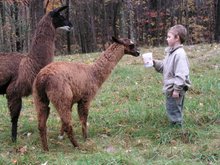
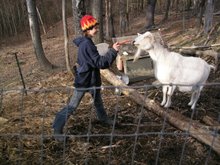

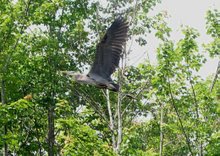

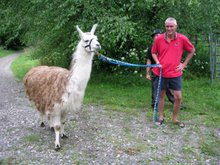
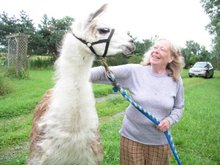
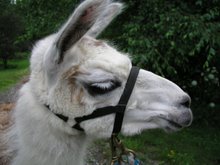








No comments:
Post a Comment